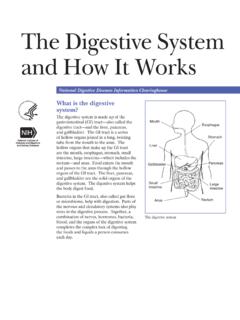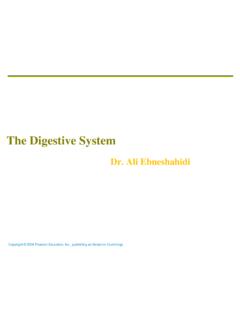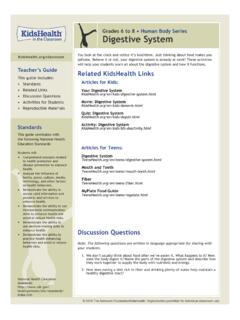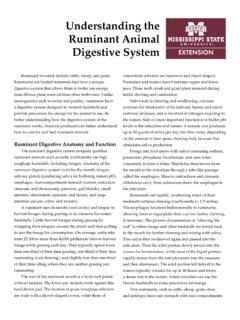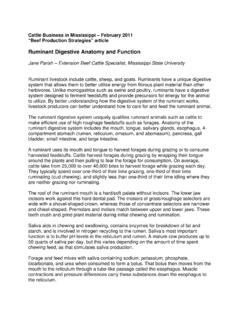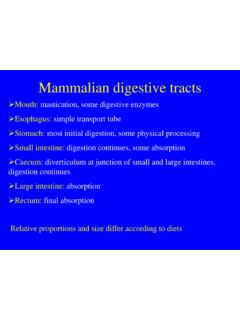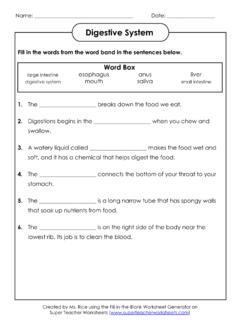Transcription of Digestive System of the Horse and Feeding Management - …
1 Agriculture and Natural Resources FSA3038 Digestive System of the Horse and Feeding Management Steven M. Jones Animals have different types of Extension Horse Digestive systems based on where and how they digest components. Non-Specialist ruminant systems are characterized by enzymatic digestion of carbo hydrates, proteins and fats in the foregut, with limited fiber digestion in the hindgut. Digestive systems of man, pigs and dogs are examples of this type of digestion. Ruminants, such as cows, sheep and deer, have more complex Digestive systems which allow fiber digestion in the rumen, enzymatic digestion in the foregut and relatively minimal digestion of fiber in the hindgut.
2 The Horse s Digestive System is somewhat intermediate between other nonruminants and ruminants in that high rates of enzy matic digestion occur in the foregut (mouth to ileum); plus, high rates of fermentive microbial digestion occur in the hindgut (cecum to rectum). The Horse is classified as a nonruminant herbivore a roughage eater. Figure 1 shows the Horse s Digestive tract with approximate lengths and capacities of various compartments of the tract. Accessory organs that aid in digestion (not shown) include the teeth, salivary glands, liver and pancreas. Arkansas Is Our Campus Visit our web site at: This diagram has been stretched out for demonstration purposes and thus is not anatomically correct.
3 Figure 2 is a closeup of the major components of the Horse Digestive tract. Figure 2. Components of Horse Digestive Tract The foregut includes the mouth, esophagus, stomach and small intestine. Digestion begins in the mouth where feeds are chewed and wetted with saliva. The chewing process cracks the outer shell of grains, reduces the particle size of feeds and increases the surface area of food particles. Figure 1. Digestive Tract of the Horse University of Arkansas, United States Department of Agriculture, and County Governments Cooperating The Horse s stomach is small, relative to the total tract, and cannot accommodate large quantities of food at any one time, resulting in eating several times per day due to limited one-time capacity.
4 Limited enzymatic digestion and some fermentive digestion from a small microbial population occurs in the stomach. Food remains in the stomach only about 15 minutes before it starts to pass into the small intestine. This limited capacity and any excess gas products in the stomach can cause the rupture of the stomach, other Digestive upsets and death. The small intestine is the site for a major portion of nutrient absorption. Here soluble carbohydrates are digested to simple sugars and absorbed for use as energy. Efficiency of carbohydrate digestion in the small intestine appears to be important to increase the energy available to the Horse and decrease the potential for colic or founder caused by excessive carbohydrates reaching the hindgut.
5 The small intes tine appears to be the primary site for fat digestion and absorption. Diets containing 10 to 15 percent fat can be tolerated and used for energy. About 50 to 70 percent of the protein in grain-based diets is digested to amino acids and absorbed from the small intestine, but less than one-third of hay protein is absorbed from the upper tract. The fat soluble vita mins A, D, E and K are also absorbed in the small intestine along with B-vitamins, calcium and some phosphorus. Passage of feeds through the small intestine takes approximately 30 to 90 minutes. The Horse s hindgut includes the cecum, large colon, small colon and rectum.
6 The cecum hangs against the right side of the abdominal cavity at the juncture of the Horse s body trunk and hind leg. During or immediately after a Horse eats, gut sounds, which are mixing activities of the cecum, can be heard normally by placing one s ear against the abdominal wall in the area of the cecum. Veteri narians routinely listen for these gut sounds when diagnosing Digestive disturbances. Absence of gut sounds may indicate abnormal cecal activity. The Horse s hindgut contains an active population of bacteria and protozoa similar to that of the rumen in ruminants. Microbes break down fibrous feeds into short-chained volatile fatty acids.
7 This microbial action allows the Horse to efficiently utilize forages, either green or cured. Volatile fatty acids are an energy source for the Horse , and the amount and proportion produced can be altered by composition of the diet. Starch that reaches the hindgut is fermented to volatile fatty acids plus lactic acid. Again, Digestive disorders can occur when excessive amounts of soluble carbohydrate reach the hindgut, causing an excess of lactic acid to be produced. Therefore, maxi mizing starch digestion in the foregut is of the utmost importance to horsemen. Microbes synthesize amino acids in the large intestine, but essential amino acids are not absorbed in any appreciable quantity from the hindgut.
8 This means that, unlike the ruminant, the Horse cannot eat low quality protein feeds and then convert this protein into higher quality protein for absorption and use in the body. Considerable amounts of B-vitamins are synthesized by the microbes in the hindgut and are absorbed. It appears that thiamine is not absorbed in sufficient quantities to meet the require ments of hard-working horses and, therefore, should be added to the rations of those horses that are classed as hard-working ( , jumping, roping, endurance riding, racing). Rate of passage through the cecum and large intestine is 36 to 72 hours.
9 Many factors can influence the digestibility of nutrients in the complex Digestive tract of the Horse . These include type of feedstuff, level of maturity of forage, method of processing feedstuffs, quantity fed, frequency of Feeding , rate of passage and age and individual differences among horses. Feeding Management Guidelines Horses require different amounts of nutrients in their daily diets depending upon their nutritional class or status in life. Table 1 lists the nutritional requirements of horses as determined by the National Research Council. For this discussion, the classes are mature idle, working, growing and stage of repro duction.
10 Dividing horses into classes relative to nutri ent requirements is the first step in designing a workable Feeding Management program. This approach helps a Horse owner meet each Horse s nutrient requirements in the most manageable and economical fashion. The following suggestions should help in designing your Feeding Management program. 1. Feed horses according to body weight. Table 2 shows recommended daily feed intakes by horses as a percent of body weight. The most accurate method of determining body weight is to weigh the Horse on a scale. Where weighing is impractical, weight tapes or body measurement formulas can be used.
